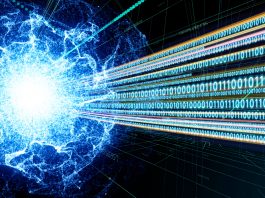Researchers at the Max Planck Institute of Quantum Optics have utilised a quantum gas microscope to explore the behaviour of microscopic quantum magnets.
The behaviour of microscopic quantum magnets has been a topic of study and debate in theoretical physics for many years. However, exploring the dynamics of systems out of equilibrium and studying them has been challenging.
To overcome this obstacle, a team at the Max Planck Institute of Quantum Optics (MPQ) has utilised a quantum gas microscope to learn more about the behaviour of microscopic quantum magnets. By using this quantum gas microscope, it is possible to manipulate and image quantum systems at such high resolution that individual atoms are visible.
Investigating linear chains of spins
The findings of the group’s experiments on linear chains of spins indicate what is known as ‘Kardar-Parisi-Zhang superdiffusion’. This reinforces a hypothesis that recently arose from theoretical considerations.
The team at MPQ in Garching – based around Dr Johannes Zeiher and Professor Immanuel Bloch – utilised the quantum gas microscope to uncover the processes on the tiny scale of quantum physics. With the assistance of atoms and lasers, this tool enables the development of quantum systems with the required properties. The researchers were able to study the quantum systems in high resolution and investigate how quantum objects move under external conditions.
The group has now made a remarkable experimental discovery; they were able to demonstrate that the one-dimensional transport of spins – a specific, magnetic quantum property of atoms and other particles – resembles macroscopic phenomena in particular areas.
Generally, processes in the quantum realm and in everyday life are incredibly different. However, Johannes Zeiher, group leader in the Quantum Many-Body Systems division at MPQ, explained: “Our work reveals an interesting connection between quantum mechanical spin systems in cold atoms and classical systems such as growing bacterial colonies or spreading wildfires.
“This discovery is completely unexpected and points to a deep connection in the field of non-equilibrium physics that is still poorly understood.”
Physicists describe such a theoretical analogy between random motion in quantum and classical systems as ‘universality’. In this instance, it is the Kardar-Parisi-Zhang universality (KPZ) – a phenomenon formerly known only from classical physics.
Undertaking microscopic examination
In order to examine the phenomenon microscopically, the researchers cooled down a cloud of atoms to temperatures close to absolute zero. This was done so that movements due to heat could be ruled out.
The team then locked the ultracold atoms in a specially formed ‘box-shaped’ potential, established by an array of small mirrors. “We used this to study the relaxation of a single magnetic domain wall in a chain of 50 linearly arranged spins,” clarified David Wei, a researcher in Johannes Zeiher’s group. The domain wall distinguishes zones with the same orientation of neighbouring spins from each other. The team first produced the domain wall for the experiment using a method where an ‘effective magnetic field’ was created by projecting light. Through this, the team were able to strongly subdue the couplings between spins, essentially “locking” them into place.
The relaxation within the spin chain took place after the couplings between spins were turned on in a controlled manner and followed a characteristic pattern. “This can be described mathematically by a power law with the exponent 3/2,” explained Wei.
The researchers found further evidence for this connection with KPZ universality with the detection of the motion of individual spins, which was uncovered through the quantum gas microscope.
“This high precision was the basis for a detailed statistical evaluation,” added Zeiher. “The striking course of spin diffusion that our experiment showed corresponds in its mathematical form approximately to the spread of a coffee stain on a tablecloth, for example.”
For the description of quantum mechanical spin phenomena, physicists have been using the so-called ‘Heisenberg model’ very successfully for a long time. However, it was only recently that spin transport phenomena could be explained theoretically within this mode. “Our results show that surprising new insights are still possible even within an established theoretical framework,” Johannes Zeiher stressed. “And they are proof of how theory and experiment cross-fertilise in physics.”
The team’s findings may have important technological applications. For example, spins also constitute the basis of specific quantum computers. Therefore, understanding the transport properties of the information carriers may be significant for the practical realisation of new computer architectures.









